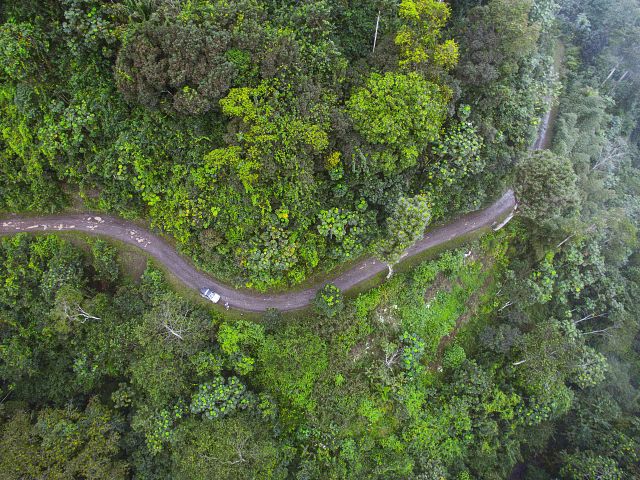Is the real message behind the Sendai Framework for Disaster Risk Reduction being overlooked?
Missing the forest for the trees
May 26, 2022

The Rio Provaz basin in Sao Tome and Principe, which has been affected by disasters in recent years.
This year marks the convening of the 7th Session of the Global Platform on Disaster Risk Reduction (GPDRR) under the theme, “Risk to Resilience: Towards Sustainable Development for all in a COVID-19 Transformed World”, taking place from 23-28 May in Bali, Indonesia.
This event is of particular importance, in that it not only represents the first time that the global DRR community can convene in an (albeit hybrid) in-person/online setting in the past two years, but also that we are in the seventh year of the global efforts to advance the Sendai Priorities for Action and taking stock of the progress in achieving the identified global targets of the Sendai Framework for measuring progress on reducing disaster risk and losses, in accordance with the Sustainable Development Goals (SDGs).
Thus, as we are literally living in a COVID-19 transformed world, this year’s event and its theme takes on increased significance. It is of utmost urgency that the development community and governments engage in deep thought on what our commitments to deliver on these key priorities of the Sendai Framework means and requires. Especially given the ambitious SDG aspirations, and, frankly, the challenges posed to these aspirations by systemic risks and the inability of the current institutional arrangements to manage them let alone move towards real resilience.
No such thing as “natural” disasters
In 2015, the year that the Sendai Framework was implemented, there were 395 disasters triggered by natural hazards, according to the Center for Research on the Epidemiology of Disasters (CRED). In 2016, that number was 342, and this number has continued to ebb and flow while remaining near the annual average of the previous decade (peaking with 432 catastrophic events in 2021). While that’s not to say the severity and impact hasn’t increased (it certainly has), there is a correct sense that a relatively consistent number of natural hazard events are predictable.
When the Sendai Framework was implemented in 2015, there was a prevailing sense in many of the countries that have had to grappled with disasters, that these events are solely “an act of God” or that nature is simply unforgiving or historically too harsh on their respective communities.
The urgency to act on the real cause of the devastating impacts of these hazard events is often disrupted by the still lingering view that the events themselves are uncontrollable. A view often reflected in the use of phrase “natural disasters”, when, in point of fact, there is no such thing.
In reality, all disasters are human-caused or human-induced. The suggestion that disasters are natural is and has subconsciously manifests and encouraged a sense of powerlessness.
Ideally, it is important that we separate the “event” (which we may not be able to control), from the magnitude of the impact caused by a failure of the social and economic systems to sustain pre-event conditions of life.
If the real goal of the Sendai Framework is to reduce disaster risks and losses, then it is incumbent of governments, international agencies and civil society at large to recognize their collective role in investing to reduce the drivers of risk as a necessary path to building resilience.
A (relatively) simple equation
Disasters are the consequence of the interplay between an event, the people, infrastructure and goods exposed, and the capacity of the system to effectively deal with the impact.
If we consider this like a mathematical equation: risk is equal to a hazard multiplied by exposure and vulnerability, divided by capacity. If exposure and vulnerability are high while capacity is low, the risk is significantly elevated. Conversely, if exposure and vulnerability are low while capacity is high, the risk is reduced.
This is the essence of disaster risk reduction.
The answer to our efforts to move towards a Sustainable Development Agenda lies within this simple equation. If our objective is truly sustainable development, then our mission as development practitioners and affected community members is to identify and manage the risks whether they be systemic or synchronous. This means decreasing the probability of disruption by increasing capacities and reducing exposure and vulnerability.
These are the variables we can control. The key question to ponder, as we come together at this seventh global gathering to reflect and discuss matters related to the Sendai Framework priorities, is whether all share this common view that risk is a social construct that can be managed, and if we are truly harmonizing and orienting our resources towards minimizing or eliminating the key drivers of risks (such as inequality, poor governance, unlawfulness, injustice or environmental degradation).
After all these are matters of development, they require a long-term focus. The natural hazard is the “trigger” that shines a light on where “bad development” still exists. It should motivate us to course correct development pathways on the journey towards resilience.
The Sendai Framework brings into sharp focus the areas where we must invest to minimize the probability of an adverse event eroding hard-won development gains. This is, in the end, the importance of Sendai as an essential enabler of Sustainable Development.
Applying an approach to development that is “risk Informed” as a means of resetting the trajectory of the development pathways is key to reaching the most vulnerable communities. As we have come to know, natural hazard events will always continue, and they are in a sense nature’s own demonstration of resilience. However, if we can focus efforts on the controllable side of the equation to ensure no one is being left behind, then we will be well on our way to building resilient societies together. The convening of key actors here at the GPDRR, taking place in a COVID-19 transformed world, is the first step in that process.

 Locations
Locations